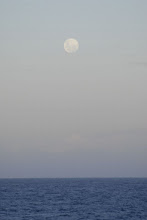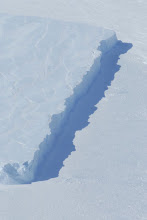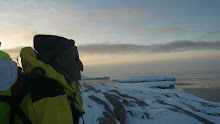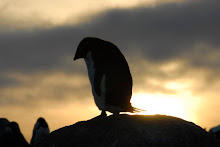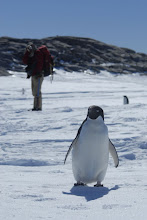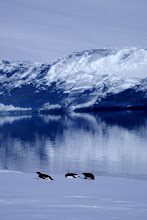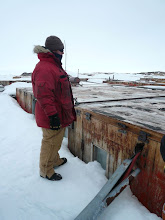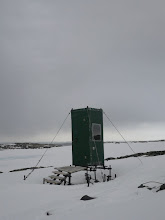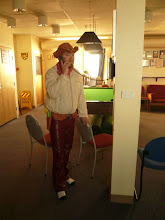
Sunrise... 11:30am

Midday... 12:40pm Sunset... 1:50pm
Sunset... 1:50pm
 Sunset... 1:50pm
Sunset... 1:50pmIts 10:45am here, and there’s a thin line of orange starting to appear on the northern horizon. For the past hour the features of the landscape have been slowly emerging from darkness, and are only now starting to take the shapes and forms that have become quite familiar to me. It’s funny that after 8 months here, I’ve even learnt to take 30m high ice-cliffs and distant kilometre wide bergs for granted, at times. But on a good morning like this I’m brought back to the reality of where I am and what brought me here. In another half an hour the scene is better lit, illuminated by splashes of orange and red protruding from the bottom of a thin layer of cloud. Another half an hour still and splashes of colour become brilliant flames reaching down from the sky toward the ground. 

Unlike the mid latitudes, where these brilliant moments of sunrise and sunset last only a matter or minutes, here they can last for an hour. The rising sun makes such an angle with the horizon, and moves in such a shallow arc, that at mid-day it is only about 5 degrees above the surface of the far stretching sea-ice, and if I look to the south at this time on a clear day there is still a band of deep pastel blue in the sky, mixed with a layer of soft pink, that tells me the night has only retreated a little way in that direction, and briefly, but will soon return for another long night. 

Looking towards the southern moon at midday
In the mess, where we eat, one of the plumbers is staring from the window toward the distant north; as I pass through the wallow, our living room, one of the mechanics is likewise fixated by the rising sun; and outside I can see one of our communications technicians with a camera and tripod, setting up to capture the moment. But a photo wont do the scene justice… none of mine do anyway. As I get to the operations building, where I work, I pass the Station Leader’s office - he’ s taking some time out and standing, hands on hips, at a window which faces north. We’ve had some bad weather lately, lots of wind and snow, and haven’t seen the sun for a good few days. But now, as the dawn appears to be breaking from a long night (even by local standards), the station has paused, briefly, to take it in. It’s probably my imagination more than anything, but it feels like a special sunrise.  We’re just a few days from the mid-winter solstice, and the sun has travelled more or less as far north as it is planning to for the entire year. Soon it will begin to move south again, and the seemingly eternal night will retreat south of Casey as daylight hours return. Instead of rising in the far north north east and setting in the far north north west, the sun will start to rise from a more easterly position, and set further to the west.
We’re just a few days from the mid-winter solstice, and the sun has travelled more or less as far north as it is planning to for the entire year. Soon it will begin to move south again, and the seemingly eternal night will retreat south of Casey as daylight hours return. Instead of rising in the far north north east and setting in the far north north west, the sun will start to rise from a more easterly position, and set further to the west. Midday sun over Casey
Midday sun over Casey
 We’re just a few days from the mid-winter solstice, and the sun has travelled more or less as far north as it is planning to for the entire year. Soon it will begin to move south again, and the seemingly eternal night will retreat south of Casey as daylight hours return. Instead of rising in the far north north east and setting in the far north north west, the sun will start to rise from a more easterly position, and set further to the west.
We’re just a few days from the mid-winter solstice, and the sun has travelled more or less as far north as it is planning to for the entire year. Soon it will begin to move south again, and the seemingly eternal night will retreat south of Casey as daylight hours return. Instead of rising in the far north north east and setting in the far north north west, the sun will start to rise from a more easterly position, and set further to the west. Midday sun over Casey
Midday sun over Casey On a rare clear day we will get maybe 3 or 4 hours of visible light in a day, even though the sun is technically only “up” for two and a bit hours in every 24. But on more commonly overcast days we probably only have 2 hours or so of light – and by “light” I mean a grey diffuse glow, just enough to turn the headlights off while driving. Nothing to get overly excited about.
When I first started to calculate how many hours of darkness we would be getting during the “winter” I was disappointed to find that even at the solstice we would not be getting the famed “24 hours darkness” that springs to mind when ones thinks of the polar regions of the globe (we are just a little north of the Antarctic circle). Now, just a few days from this point, I can safely say that 21 hours darkness gives you a pretty good idea. 21 hours? 24 hours? Lets not get caught up in the detail. Between you and I, I think I’m glad the sun is almost ready to start moving south again.




